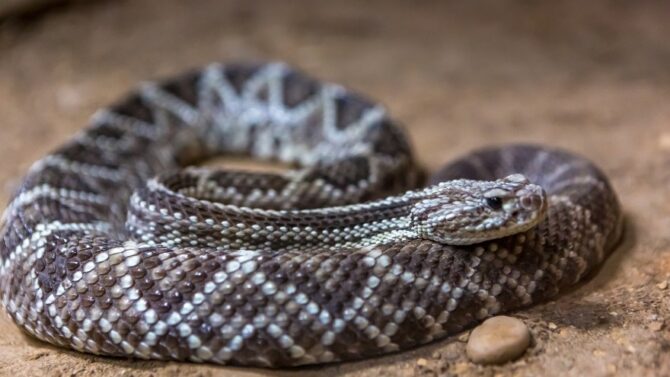Virginia is officially called the Commonwealth of Virginia, and it is a state found in the southeastern region of the United States of America.
In Virginia, you will see the Chesapeake bay and the Blue ridge mountains. These spots are some of the habitats both animals and plants dwell.
In this article, we’ll focus on owls, the birds of prey with a mixed reputation.
There are 8 species of owls in Virginia. These birds have made the state their home, either permanently or otherwise. They include the great horned owl, barn owl, eastern screech owl, and barred owl, to mention a few.
Read on to unpack the interesting details of all these creatures, including facts on how to recognize the different species based on their appearance, sounds, and migratory patterns.
The 8 Species of Owls in Virginia
1. Barn Owl
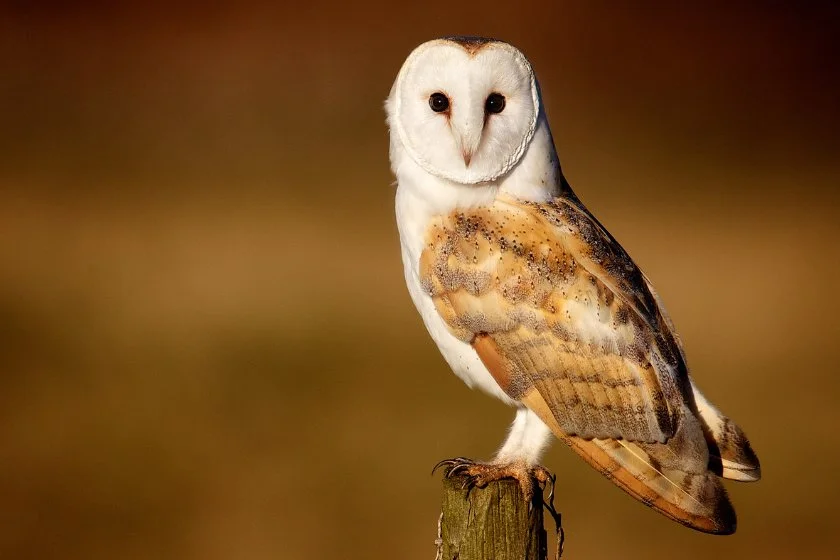
- Length: 13 to 16 inches
- Weight: 14 to 25 pounds
- Wingspan: 39 to 49 inches
- Scientific name: Tyto Alba
The first bird on our list holds the title of being the most widespread owl in the world. It also is one of the most widespread birds in general.
The barn owl bears many other names like the common barn owl, the church owl, the monkey-faced owl, and even names like demon owl and ghost owl.
The last two names were given thanks to the barn owl’s looks. It combines black eyes with a pale, heart-shaped face, which comes off as ghostly for many people.
Colors of other parts of the body vary amongst subspecies, but you’ll find pale brown or a richer one, grey, with white or reddish buff on the underparts. Added to these are speckles.
As the name implies, barn owl lives in barns and even abandoned churches. Some farmers try to attract this bird because it serves as a good form of rodent control.
The bird is nocturnal in many places like Virginia, so the best time to see it in action is at night. To locate it, listen to its sound. Barn owls don’t hoot, they let out a prolonged screech.
2. Great Horned Owl
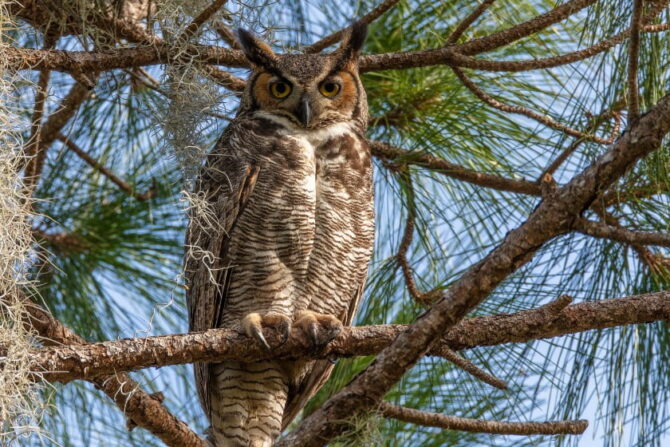
- Length: 18 to 25 inches
- Weight: 32 to 88 pounds
- Wingspan: 40 to 57 inches
- Scientific name: Bubo virginianus
The great horned owl is the most distributed true owl in the Americas, where it is a native. This bird can also be called the tiger owl or the hoot owl.
What makes it widely distributed is its high adaptability, and it can inhabit a wide range of habitats.
The great horned owl is also the classic type of owl, down to the hoot. This makes it easily recognizable.
In Virginia, the great horned owl occurs all year. Its preferred habitat in the state includes different types of forests (deciduous, evergreen…) and swamps.
Some can come out during the day, but the best time to locate one is at night. Listen out for the hooting that’s often associated with owls.
The great horned owl has an overall color of mottled brown, with the underparts being lighter than the top. Then there’s the white patch found on the throat, feather tufts that are called horns, and a facial disc.
For food, the great horned owl feeds on a variety of meals, ranging from mammals to reptiles. Its dietary options are broad.
3. Barred Owl
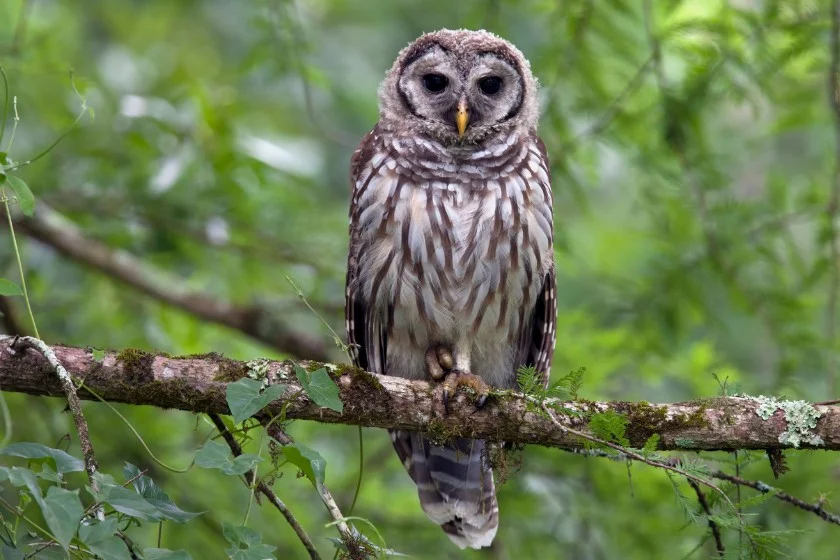
- Length: 17 to 20 inches
- Weight: 16 to 37 pounds
- Wingspan: 39 to 43 inches
- Scientific name: Strix varia
The barred owl is a species often found in North America and is named thanks to the dark bars or stripes on the underside. It is also named the northern barred owl or the striped owl.
More informally, the barred owl can also be called the hoot owl. It often stays in mature forests but can also inhabit some other habitats like open woodlands.
In Virginia, it occurs all year round. To locate these birds, look for deciduous and evergreen forests. They often sleep during the day and become more active at nightfall when they come out to hunt.
They are opportunistic predators, going after the next available prey. Examples of animals the barred owl feeds on are voles, amphibians, and invertebrates.
The barred owl has an overall brown or greyish-brown color, and its most prominent physical feature is the stripes. Because it hoots, one may confuse it with the great horned owl.
To distinguish them, listen out for a series of eight accented hoots in groups of four: hoohoo-hoohoo, hoohoo- hoohooaw. The barred owl’s hoot is also more emphatic and loud.
4. Eastern Screech Owl

- Length: 6 to 10 inches
- Weight: 4 to 9 pounds
- Wingspan: 19 to 24 inches
- Scientific name: Megascops Asio
The eastern screech owl is quite common in the eastern parts of North America, ranging from Mexico to Canada.
It occurs all year round in Virginia, but sighting one can be quite difficult as it tends to avoid detection and camouflages well in trees.
You’d often find these birds in wooded habitats like woodlands, deciduous forests, parklands, and wooden suburban areas.
They tend to stay away from areas with bigger birds, like the great horned owl and the barred owl.
The eastern screech’s overall color is grey and red-brown, the combination of which helps with the camouflage.
Its nocturnal nature also makes it possible for the eastern screech owl to blend almost perfectly with the trees.
The only certain way to detect this bird is with the trill, almost the sound of a horse whinnying. You can also attract the owl to your house with a nest box, usually by April when breeding starts.
The eastern screech owl feeds mainly on insects during the breeding season, like crickets, beetles, moths, grasshoppers, and cicadas.
In addition to insects, it also feeds on snails, spiders, worms, and small mammals.
5. Long-eared Owl

- Length: 14 to 16 inches
- Weight: 8 to 15 pounds
- Wingspan: 35 to 39 inches
- Scientific name: Asio otus
The long-eared owl is also known as the northern long-eared owl, the cat owl, and the lesser horned owl.
Just as the names imply, the long-eared owl looks like a cat and has long ear tufts that are quite visible.
The ones found in Virginia are non-breeding. Like the eastern screech owl, the long-eared is hard to detect because of its camouflage skills.
The overall color of this creature is either brownish or dark gray, which aids it in blending in with the environment. It is also strictly nocturnal, adding to the difficulties of finding it.
Like other owls, the best way to find the long-eared owl is through its sound. It makes a lot of vocal calls, but one you can especially listen out for is the male’s whoop or the female’s tin whistle.
Females have a weaker voice and do not call out as much as males.
Other physical traits include a slim figure and long wings, which are relatively long for their size.
6. Short-eared Owl
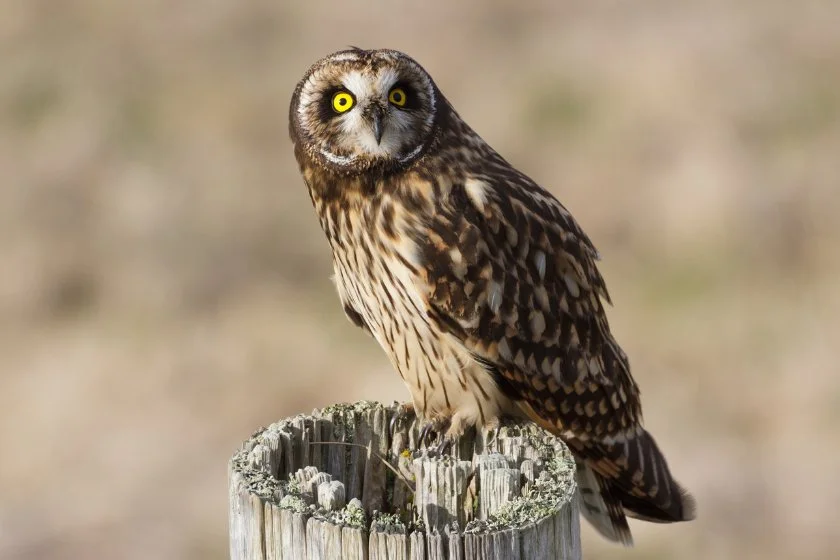
- Length: 13 to 17 inches
- Weight: 7 to 17 pounds
- Wingspan: 34 to 41 inches
- Scientific name: Asio flammeus
Short-eared owls in Virginia are also of the non-breeding kind, much like long-eared owls. It is a grassland species and is related to the long-eared owl, as they both belong to the Asio genus.
The difference between both species is evident in the name. The short-eared owl has small ear tufts which aren’t easily seen. As a grassland species, you should expect to see it in open habitats.
The good thing about this owl is that you can see it both at night and during the day. This means you can look for it both at dawn and dusk.
You’d recognize the short-eared owl by its pale face, yellow eyes, and broad wings. Its overall color is mottled brown, and there are bars on the tails and wings.
You can also locate it through sound. It has a scratchy sound, much like a bark.
7. Snowy Owl
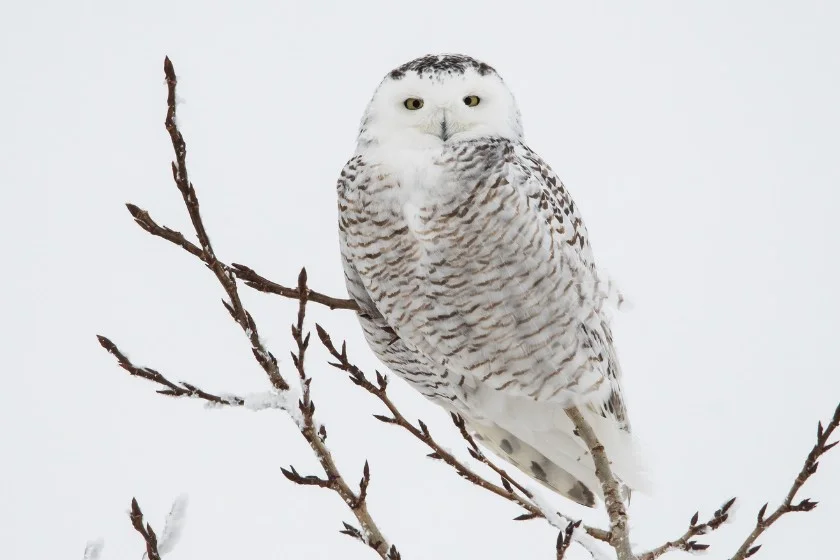
- Length: 21 to 28 inches
- Weight: 56 to 101 pounds
- Wingspan: 50 to 57 inches
- Scientific name: Bubo scandiacus
The snowy owl is also known as the polar owl, the artic owl, or the white owl. These birds don’t occur year-round in Virginia, so sighting them isn’t always easy.
They live in the arctic tundra but tend to migrate to different places during the year. They appear in Virginia occasionally during their migration.
If you do see one, snowy owls are hard to miss. They’re large, for starters, even more than the great horned owl.
They also have striking white plumage, though only very few individuals are fully white.
Usually, they have some touches of black. Males are generally whiter than females, and younger ones tend to get lighter with age.
The snowy white is active both during the day and at night, so whenever they are around in Virginia, you won’t have a problem seeing them. Like other owls, they feed on rodents and many other small mammals.
8. Northern Saw-whet Owl
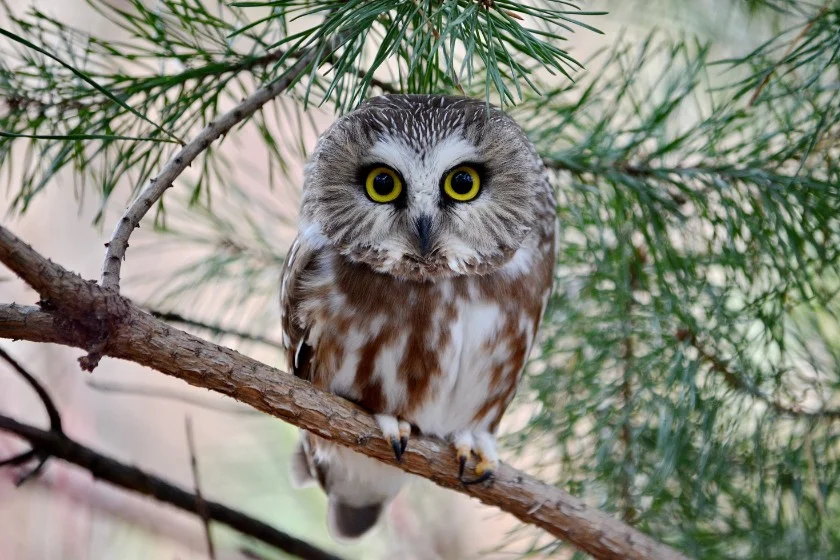
- Length: 7 to 9 inches
- Weight: 2 to 5 pounds
- Wingspan: 17 to 22 inches
- Scientific name: Aegolius acadius
The northern saw-whet owl is a small owl species belonging to the family Strigidae. In Virginia, only a nonbreeding population can be found.1
It isn’t as common as other owl species, and because of its size, it is hard to find. The best way to see the northern saw-whet is to listen for its distinct sound from which it got its name.
People say the sound is like a saw being sharpened on a whetstone.
If you do see one, you’ll recognize it by the round, light face and brown or cream streaks. It also has yellow eyes, a dark beak, and a noticeable absence of ear tufts.
It also tends to rustle up small birds who try to chase it away, so when you see sunbirds making a fuss, there’s a high chance a saw-whet owl is close by.
Conclusion
There are a couple of animals that live in Virginia; amongst them, you’ll find different owl species, eight in total.
Some of these owls in Virginia can be found all year round, while others are rare and have a particular period you can see them.
Next up…
References & Notes
Facts Sources:
- Northern Saw-Whet Owl. Owl Research Institute.




